ASM Metals HandBook Vol. 17 - Nondestructive Evaluation and Quality Control
Подождите немного. Документ загружается.


The principles of radiation safety have evolved from experience in health physics, which is the study of the biological
effects of ionizing radiation. There are two main aspects of safety: monitoring radiation dosage and protecting personnel.
This section summarizes the major factors involved in both. More detailed information on radiation safety is available in
the Selected References at the end of this article.
Radiation Units. Ordinarily, x-ray and -ray radiation is measured in terms of its ionizing effect on a given quantity of
atoms. The roentgen, as described in the section "Radiation Sources" in this article, is a unit derived on this basis for x-
rays and -rays. However, even though the amount of x-ray and -ray exposure can be quantified in the roentgen unit,
the effects of radiation on the human body also depend on the amount of energy absorbed and the type of radiation.
Consequently, the roentgen equivalent man (rem) unit and the SI-based sievert (Sv) unit have been developed for the
purposes of radiation safety. As described below, these two units include safety factors assigned to the absorbed energy
dose of a particular type of radiation (where the absorbed energy dose is measured either in the radiation absorbed dose,
or rad, unit or the SI-based gray unit).
Rem and Rad Units. The specification of radiation in rems is equal to the product of the rad and a factor known as the
relative biological effectiveness (rbe). The rbe (as established by the U.S. Government) is 1.0 for x-rays, -rays, or
particles; 5.0 for thermal neutrons; 10 for fast neutrons; and 20 for particles. One rad represents the absorption of 100
ergs of energy per gram of irradiated material; it applies to any form of penetrating radiation.
Sievert and Gray Units. A sievert is the SI-based version of the rem unit. The same rbe factors are used, but the
sievert unit is derived from the absorbed dose specified in the SI-based gray (Gy) unit. Because 1 Gy represents the
absorption of one joule of energy per kilogram of material, then 1 Gy = 100 rads and 1 Sv = 100 rem.
Units for X-Rays and -Rays. Because 1 R (which applies only to the ionizing effect of x-rays or -rays)
corresponds to the absorption of only about 83 ergs per gram of air, the unit of 1 R can be considered equal to 0.01 Gy (1
rad) for radiation-safety measurements. With this approach, then, the measurement of x-ray and -ray dose in roentgens
can be considered equivalent to direct measurement of dose in rems because the rbe is equal to one. This considerably
simplifies the process of monitoring dose levels.
Maximum Permissible Dose. Current practice in health physics specifies a threshold value of accumulated dose
above which an individual should not be exposed. The value of this threshold, or maximum permissible dose, increases at
the rate of 0.05 Sv/yr (5 rem/yr) for all persons over the age of 18. This so-called banking concept is based on experience
and assumes that no person will be exposed to penetrating radiation before the age of 18. The total amount of radiation
absorbed by any individual should never exceed his continually increasing accumulated permissible dose; furthermore, no
individual should be exposed to more than 0.12 Sv (12 rem) in any given year, regardless of other factors. For
administrative purposes, maximum permissible dose rate is evaluated for each individual on a quarterly or weekly basis.
The applicable dose rates are 0.0125 Sv (1 rems) per calendar quarter, or about 1 millisievert (1 mSv, or 100 mrem) per
week.
Radiation Protection. The two main factors in radiation protection are controlling the level of radiation exposure and
licensing the facility. The main criterion in controlling radiation exposure is the philosophy outlined in Regulatory Guide
8.10 of the United States Nuclear Regulatory Commission, which specifies the objective of reducing radiation exposures
to a level as low as reasonably achievable. The licensing process involves the issuance of permission for operating a
radiographic facility; permission may be required from federal, state, and local governments.
The federal licensing program is concerned with those companies that use radioactive isotopes as sources. However, in
some localities, state and local agencies exercise similar regulatory prerogatives. To become licensed under any of these
programs, a facility or operator must show that certain minimum requirements have been met for the protection of both
operating personnel and the general public from excessive levels of radiation. Although local regulations may vary in the
degree and type of protection afforded, certain general principles apply to all.
First, the amount of radiation that is allowed to escape from the area over which the licensee has direct and exclusive
control is limited to an amount that is safe for continuous exposure. In most cases, total dose values of 0.02 mSv (2 mrem)
in 1 h, 1 mSv (100 mrem) in 7 consecutive days, and 5 mSv (500 mrem) in a calendar year can be considered safe. These
values correspond to those adopted by the federal government for radioactive sources and are also applicable under most
local regulations. For purposes of control, unrestricted areas within a given facility are often afforded the same status as

areas outside the facility. An unrestricted area is usually defined as an area where employees are not required to wear
personal radiation-monitoring devices and where there is unrestricted access by either employees or the public.
Second, main work areas are shielded in accordance with applicable requirements. Some facilities must be inspected by
an expert in radiation safety in order to qualify for licensing; it is usually recommended that the owner consult an expert
when planning a new facility or changes in an older facility to ensure that all local requirements are met. Appropriate
shielding usually consists of lead or thick concrete on all sides of the main work area. The room in which the actual
exposures are made is the most heavily shielded and may be lined on all sides with steel or lead. Particular attention is
given to potential paths of leakage such as access doors and passthroughs and to seemingly unimportant paths of leakage
such as the nails and screws that attach lead sheets to walls and doors.
Third, portable radiation sources are used in strict accordance with all regulations. In most cases, safe operation is ensured
by a combination of:
• Movable shielding (usually lead)
• Restrictions on the intensity and direction of radiation emitted from the source during exposure
• Exclusion of all personnel from the immediate area during exposure
The best protection is afforded by distance because radiation intensity decreases in proportion to the square of the
distance from the source. As long as personnel stay far enough away from the source while an exposure is being made,
portable sources can be used with adequate safety.
Finally, access to radiographic work areas, including field sites and radioactive-source storage areas, must at all times be
under the control of competent and properly trained radiographers. Radiographers must be responsible for admitting only
approved personnel into restricted work areas and must ensure that each individual admitted to a restricted work area
carries appropriate devices for monitoring absorbed radiation doses. In addition to keeping records of absorbed dose for
all monitored personnel, radiographers must maintain accurate and complete records of radiation levels in both restricted
and adjacent unrestricted areas.
Radiation Monitoring. Every safety program must be controlled to ensure that both the facility itself and all personnel
subject to radiation exposure are monitored. Facility monitoring is generally accomplished by periodically taking readings
of radiation leakage during the operation of each source under maximum-exposure conditions. Calibrated instruments can
be used to measure radiation dose rates at various points within the restricted area and at various points around the
perimeter of the restricted area. This information, in conjunction with knowledge of normal occupancy, is used to
evaluate the effectiveness of shielding and to determine maximum duty cycles for x-ray equipment.
To guard against the inadvertent leakage of large amounts of radiation from a shielded work area, interlocks and alarms
are often required. Basically, an interlock disconnects power to the x-ray source if an access door is opened. Alarms are
connected to a separate power source, and they activate visible and/or audible signals whenever the radiation intensity
exceeds a preset value, usually 0.02 mSv/h (2 mrem/h).
All personnel within the restricted area must be monitored to ensure that no one absorbs excessive amounts of radiation.
Devices such as pocket dosimeters and film badges are the usual means of monitoring, and often both are worn. Pocket
dosimeters should be direct reading. One disadvantage of the remote-reading type is that it must be brought to a charger
unit to be read. Both types are sensitive to mechanical shock, which could reduce the internal charge, thus implying that
excessive radiation has been absorbed. If this should happen, the film badge should be developed immediately and the
absorbed dose evaluated.
Under normal conditions, pocket dosimeters are read daily, and the readings are noted in a permanent record. At less
frequent intervals, but at least monthly, film badges are developed and are evaluated by comparison with a set of
reference films. Because of various factors, the values of absorbed radiation indicated by dosimeters and film badges may
differ. This is particularly true at low dose rates and with high radiation energies (1 MeV or more). However, the accuracy
of both dosimeters and film badges increases with increasing dose, and at dose rates near the maximum allowable dose of
0.0125 Sv (1 rem) per calendar quarter, the readings usually check within ±20%.
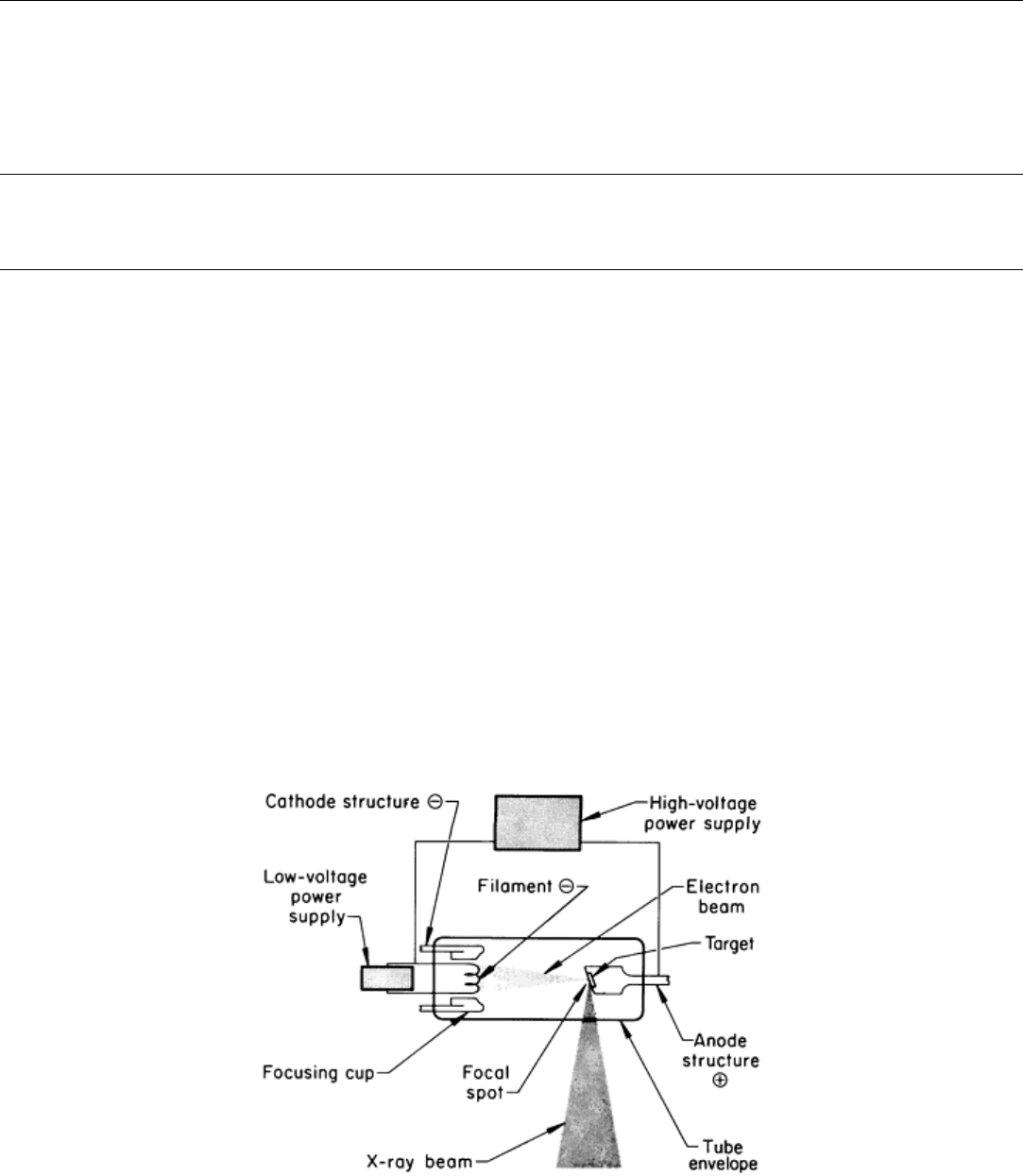
Access Control. Permanent facilities are usually separated from unrestricted areas by shielded walls. Sometimes,
particularly in on-site radiographic inspection, access barriers may consist only of ropes. In such cases, the entire
perimeter around the work area should be under continual visual surveillance by radiographic personnel. Signs that carry
the international symbol for radiation must be posted around any high-radiation area. This helps to inform bystanders of
the potential hazard, but should never be assumed to prevent unauthorized entry into the danger zone. In fact, no
interlock, no radiation alarm, and no other safety device should be considered a substitute for constant vigilance on the
part of radiographic personnel.
References cited in this section
1.
Radiography & Radiation Testing, Vol 3, 2nd ed., Nondestructive Testing Handbook,
American Society for
Nondestructive Testing, 1985
2.
R. Halmshaw, Nondestructive Testing, Edward Arnold Publishers, 1987
Radiographic Inspection
Revised by the ASM Committee on Radiographic Inspection
*
X-Ray Tubes
X-ray tubes are electronic devices that convert electrical energy into x-rays. Typically, an x-ray tube consists of a cathode
structure containing a filament and an anode structure containing a target--all within an evacuated chamber or envelope
(Fig. 7). A low-voltage power supply, usually controlled by a rheostat, generates the electric current that heats the
filament to incandescence. This incandescence of the filament produces an electron cloud, which is directed to the anode
by a focusing system and accelerated to the anode by the high voltage applied between the cathode and the anode.
Depending on the size of the focal spot achieved, x-ray tubes are sometimes classified into three groups:
• Conventional x-ray tubes with focal-
spot sizes between 2 by 2 mm (0.08 by 0.08 in.) and 5 by 5 mm
(0.2 by 0.2 in.)
• Minifocus tubes with focal-spot sizes in the range of 0.2 mm (0.008 in.) and 0.8 mm (0.03 in.)
• Microfocus tubes with focal-spot sizes in the range of 0.005 mm (0.0002 in.) and 0.05 mm (0.002 in.)
The design of conventional and microfocus x-ray tubes is discussed in the following section.
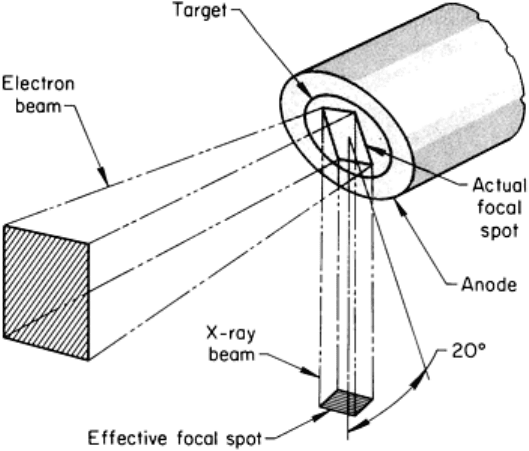
Fig. 7 Schematic of the principal components of an x-ray unit
When the accelerated electrons impinge on the target immediately beneath the focal spot, the electrons are slowed and
absorbed, and both bremsstrahlung and characteristic x-rays are produced. Most of the energy in the impinging electron
beam is transformed into heat, which must be dissipated. Severe restrictions are imposed on the design and selection of
materials for the anode and target to ensure that structural damage from overheating does not prematurely destroy the
target. Anode heating also limits the size of the focal spot. Because smaller focal spots produce sharper radiographic
images, the design of the anode and target represents a compromise between maximum radiographic definition and
maximum target life. In many x-ray tubes, a long, narrow, actual focal spot is projected as a roughly square effective focal
spot by inclining the anode face at a small angle (usually about 20°) to the centerline of the x-ray beam, as shown in Fig.
8.
Fig. 8
Schematic of the actual and effective focal spots of an anode that is inclined at 20° to the centerline of
the x-ray beam
Tube Design and Materials
The cathode structure in a conventional x-ray tube incorporates a filament and a focusing cup, which surrounds the
filament. The focusing cup, usually made of pure iron or pure nickel, functions as an electrostatic lens whose purpose is to
direct the electron beam toward the anode. The filament, usually a coil of tungsten wire, is heated to incandescence by an
electric current produced by a relatively low voltage, similar to the operation of an ordinary incandescent light bulb. At
incandescence, the filament emits electrons, which are accelerated across the evacuated space between the cathode and
the anode. The driving force for acceleration is a high electrical potential (voltage) between anode and cathode, which is
applied during exposure.
The anode usually consists of a button of the target material embedded in a mass of copper that absorbs much of the heat
generated by electron collisions with the target. Tungsten is the preferred material for traditional x-ray tubes used in
radiography because its high atomic number makes it an efficient emitter of x-rays and because its high melting point
enables it to withstand the high temperatures of operation. Gold and platinum are also used in x-ray tubes for radiography,
but targets made of these metals must be more effectively cooled than targets made of tungsten. Other materials are used,
particularly at low energies, to take advantage of their characteristic radiation. Most high-intensity x-ray tubes have
forced liquid cooling to dissipate the large amounts of anode heat generated during operation.
Tube envelopes are constructed of glass, ceramic materials or metals, or combinations of these materials. Tube envelopes
must have good structural strength at high temperatures to withstand the combined effect of forces imposed by
atmospheric pressure on the evacuated chamber and radiated heat from the anode. The shape of the envelope varies with
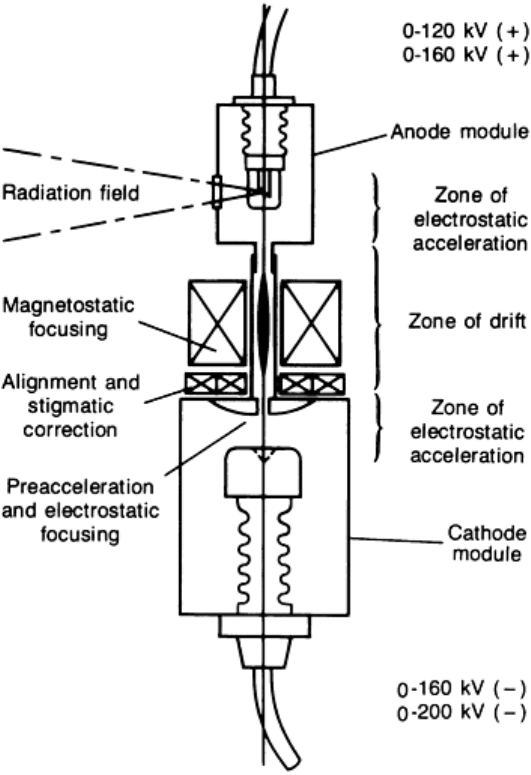
the cathode-anode arrangement and with the maximum rated voltage of the tube. Electrical connections for the anode and
cathode are fused into the walls of the envelope. Generally, these are made of metals or alloys having thermal-expansion
properties that match those of the envelope material.
X-ray tubes are inserted into metallic housings that contain an insulating medium such as transformer oil or an insulating
gas. The main purpose of the insulated housing is to provide protection from high-voltage electrical shock. Housings
usually contain quick disconnects for electrical cables from the high-voltage power supply or transformer. On self-
contained units, most of which are portable, both the x-ray tube and the high-voltage transformer are contained in a single
housing, and no high-voltage cables are used.
Microfocus X-Ray Tubes. Developments in vacuum technology and manufacturing processes have led to the design
and manufacture of microfocus x-ray systems. Some of these systems incorporate designs that allow the opening of the
tube head and the replacement of component parts, such as targets and filaments (Fig. 9). A vacuum is generated by the
use of a roughing pump and turbomolecular pumps that rapidly evacuate and maintain the system to levels as low as 0.1 ×
10
-3
Pa (10
-6
torr). Electrostatic or magnetic focusing and x-y deflection are used to provide very small focal spots and to
guide the beam to various locations on the target. Focal-spot sizes are adjustable from 0.005 to 0.2 mm (0.0002 to 0.008
in.). If the target becomes pitted in one area, the beam can be deflected to a new area, extending the target life. When the
target, filament, or other interior component is no longer useful in producing the desired focal-spot size or x-ray output,
the tube can be opened and the component replaced at minimal cost. The tube can then be evacuated to operating levels in
a few minutes or hours, depending on the length of time the tube is open to the atmosphere and the amount of
contamination present.
Fig. 9 Schematic of a microfocus x-ray tube

These systems are available with voltages varying from 10 to 360 kV at beam currents from 0.01 to 2 mA. To avoid
excessive pitting of the target, the beam current is varied according to the desired focal-spot size and/or kilovolt level
(Fig. 10).
Fig. 10 Maximum ratings for no burn-in with 200-kV cathode/120-kV anode for electron beam widths of
10
m (0.4 mil)
Microfocus x-ray systems having focal spots that approach a point source are useful in obtaining very high resolution
images. A radiographic definition of 20 line pairs per millimeter (or a spatial resolution of 0.002 in.), using real-time
radiography has been achieved with microfocus x-ray sources. This high degree of radiographic definition is
accomplished by image enlargement, which allows the imaging of small details (see the section "Enlargement" in this
article).
Microfocus x-ray systems have found considerable use in the inspection of integrated circuits and other miniature
electronic components. Microfocus x-ray systems with specially designed anodes as small as 13 mm (0.5 in.) in diameter
and several inches long also enable an x-ray source to be placed inside otherwise inaccessible areas, such as aircraft
structures and piping. The imaging medium is placed on the exterior, and this allows for the single-wall inspection of
otherwise uninspectable critical components. Because of the small focal spot, the source can be close to the test area with
minimal geometric unsharpness (see the section "Principles of Shadow Formation" in this article for the factors that
influence geometric unsharpness).
X-Ray Tube Operating Characteristics
There are three important electrical characteristics of x-ray tubes:
•
The filament current, which controls the filament temperature and in turn the quantity of electrons that
are emitted
• The tube voltage, or anode-to-cathode potential, which controls the energy
of impinging electrons and
therefore the energy or penetrating power, of the x-ray beam
•
The tube current, which is directly related to filament temperature and is usually referred to as the
milliamperage of the tube
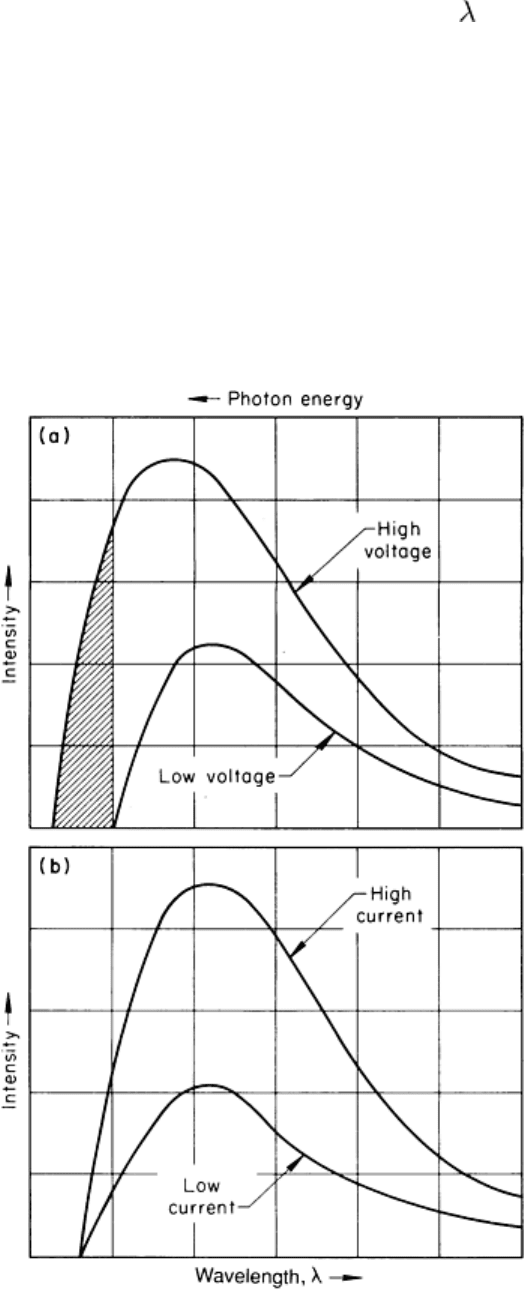
The strength, or radiation output, of the beam is approximately proportional to milliamperage, which is used as one of the
variables in exposure calculations. This radiation output, or R-output, is usually expressed in roentgens per minute (or
hour) at 1 m (as mentioned in the section "Radiation Sources" in this article).
X-Ray Spectrum. The output of a radiographic x-ray tube is not a single-wavelength beam, but rather a spectrum of
wavelengths somewhat analogous to white light. The lower limit of wavelengths,
min
, in manometers, at which there is
an abrupt ending of the spectrum, is inversely proportional to tube voltage, V. This corresponds to an upper limit on
photon energy, E
max
, which is proportional to the tube voltage, V:
E
max
= aV
(Eq 4)
where a = 11 eV/volt.
Figure 11 illustrates the effect of variations in tube voltage and tube current on photon energy and the intensity (number
of photons). As shown in Fig. 11(a), increasing the tube voltage increases the intensity of radiation and adds higher-
energy photons to the spectrum (crosshatched area, Fig. 11a). On the other hand, as shown in Fig. 11(b), increasing the
tube current increases the intensity of radiation but does not affect the energy distribution.
Fig. 11
Effect of (a) tube voltage and (b) tube current on the variation of intensity with wavelength for the
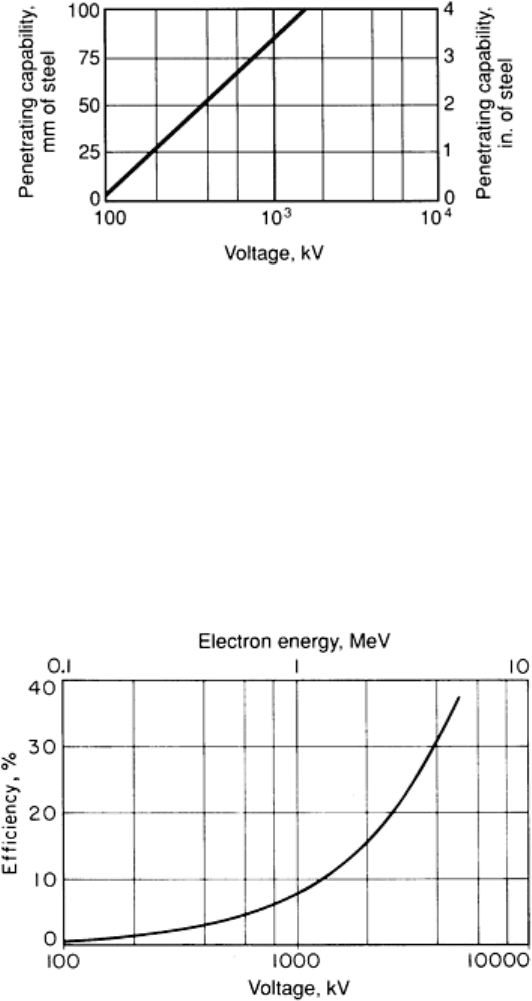
bremsstrahlung spectrum of an x-ray tube. See text for discussion.
The energy of the x-rays is important because higher-energy radiation has greater penetrating capability; that is, it can
penetrate through greater thickness of a given material or can penetrate denser materials than can lower-energy radiation.
This effect is shown in Fig. 12, which relates the penetrating capability to tube voltage. An applied voltage of about 200
kV can penetrate steel up to 25 mm (1 in.) thick, while almost 2000 kV is needed when the thickness to be penetrated is
100 mm (4 in.).
Fig. 12 Effect of tube voltage on the penetrating capability of the resulting x-ray beam
As previously stated, most of the energy in the electron stream is converted into heat rather than into x-rays. The
efficiency of conversion, expressed in terms of the percentage of electron energy that is converted into x-rays, varies with
electron energy (or tube voltage), as shown in Fig. 13. At low electron energies (tube voltages of about 100 to 200 kV),
conversion is only about 1%; about 99% of the energy must be dissipated from the anode as heat. However, at high
electron energies (above 1 MeV), the process is much more efficient, varying from about 7% conversion efficiency at 1
MeV to 37% at 5 MeV. Therefore, in addition to producing radiation that is more penetrating, high-energy sources
produce greater intensity of radiation for a given amount of electrical energy consumed.
Fig. 13 Effect of tube voltage or electron energy on the efficiency of energy conversion in the target of an x-
ray
source
The R-output of an x-ray tube varies with tube voltage (accelerating potential), tube current (number of electrons
impinging on the target per unit time), and physical features of the individual equipment. Because of the last factor, the R-
output of an individual source also varies with position in the radiation beam, position usually being expressed as the
angle relative to the central axis of the beam.
Effect of Tube Voltage. Both the mean photon energy and the R-output of an x-ray source are altered by changes in
tube voltage. The effect of tube voltage on the variation of intensity (R-output) is shown in Fig. 11(a). The overall R-
output varies approximately as the square root of tube voltage. The combined effect of greater photon energy and
increased R-output produces, for film radiography, a decrease in exposure time of about 50% for a 10% increase in tube
voltage. The effect is similar with other permanent-image recording media, as in paper radiography and xeroradiography.
Effect of Tube Current. The spectral distribution of wavelengths is not altered by changes in tube current; only the R-
output (intensity) varies (Fig. 11b). Because tube current is a direct measure of the number of electrons impinging on the
target per unit of time, and therefore the number of photons emitted per unit of time at each value of photon energy, R-
output varies directly with tube current. This leads to the so-called reciprocity law for radiographic exposure, expressed
as:
it = constant
(Eq 5)
where i is the tube current (usually expressed in milliamperes) and t is the exposure time.
The reciprocity law (Eq 5) is valid for any recording medium whose response depends solely on the amount of
radiation impinging on the testpiece, regardless of the rate of impingement (radiation intensity). For example, the
reciprocity law is valid for most film and paper radiography and most xeroradiography but not for fluoroscopic screens or
radiometric detectors, both of which respond to radiation intensity rather than to total amount of radiation. However,
radiographic films, when used with fluorescent screens, exhibit reciprocity law failure because the response of film
emulsions varies with the rate of impingement of photons of visible light (screen brightness) and with total exposure. If
tube current is decreased and exposure time is increased according to the reciprocity law, a fluorescent screen will emit
the same amount of light (same number of photons) but at a lower level of brightness over a longer period of time. The
lower brightness level will result in lower film density compared to an equivalent exposure made with a higher tube
current.
Deviations from reciprocity law are usually small for minor changes in tube current, causing little difficulty in resolving
testpiece features or interpreting radiographs made on screen-type film. However, when the tube current is changed by a
factor of four or more, there may be a 20% or more deviation from reciprocity law, and it will be necessary to compensate
for the effect of screen brightness on film density.
In most cases, when tube voltage is maintained constant, exposures made in accordance with the reciprocity law should
produce identical film densities. This assumes that tube voltage does not vary with tube current. Heavy-duty equipment
designed for stationary installations contains electrical circuitry (current stabilizers and voltage compensators) that tend to
maintain R-output in accordance with the reciprocity law. However, equipment intended for on-site use is often designed
to minimize weight, size, and cost and does not contain such complex circuitry. Consequently, the R-output and x-ray
spectrum of many portable or transportable machines vary with tube current. These types of machines may exhibit
apparent reciprocity law failure at both ends of the useful range of tube currents. For example, at currents approaching the
maximum rated current, the tube voltage tends to be depressed because of the heavy electrical load on the transformer.
This produces lower values of both R-output and mean photon energy than would normally be expected. Conversely, at
very low tube currents, the tube voltage may actually exceed the calibrated value because the transformer is more
efficient. This produces higher values of both R-output and mean photon energy than are normally expected. These
deviations from expected values are not always indicated on the monitoring instruments attached to x-ray machines.
Because of deviations from reciprocity law caused by equipment characteristics, it is often desirable to prepare exposure
charts (usually graphs) for each x-ray unit. Such charts or graphs should be based on film exposure data at several values
of tube voltage within the useful kilovoltage range of the unit. Use of these charts for determining exposure times,
especially at abnormally high or low tube currents, will help to avoid unsatisfactory image quality.
Effect of Electrical Waveform. In all x-ray tubes that are powered by transformer circuits, the waveform of the tube
voltage affects R-output. X-ray tubes are direct current (dc) devices, yet almost all power supplies are driven by
alternating current (ac). If ac power is supplied directly to the x-ray tube, the tube itself will provide half-wave
rectification. Many low-power x-ray machines use self-rectifying x-ray tubes. As illustrated in Fig. 14(a), half-wave
rectification results in a sinusoidal variation of instantaneous tube voltage with time, except that no tube current flows

(and there is no effective tube voltage) during the portion of each cycle when the anode is electrically negative, and
consequently there is no emission of x-rays during that portion of the cycle.
Fig. 14 Waveforms for accelerating potential (tube voltage) and tube current for four generally used types of x-
ray-tube circuits. (a) Half-wave rectified circuit and (b) full-wave rectified circuit, in w
hich tube voltage is equal
to the peak voltage of the electrical transformer. (c) Villard-type circuit and (d) constant-
potential circuit, in
which tube voltage is twice the peak voltage of the transformer
In a full-wave-rectified circuit (Fig. 14b), the instantaneous tube voltage varies sinusoidally from zero to peak voltage
(kVp) and back to zero, then repeats the sinusoidal pattern during the second half of each cycle. This effectively doubles
the time during which x-rays are emitted on each cycle, thus doubling the R-output compared to half-wave-rectified
equipment.
In Villard-circuit equipment, the electrical input to the x-ray tube varies sinusoidally, but as Fig. 14(c) shows, the zero
potential occurs at the minimum instantaneous tube voltage rather than at midrange. Consequently, the accelerating
potential across the tube has a peak value (kVp) that is twice the peak voltage of the transformer; for example, 2-MeV
electrons can be produced with transformer rated at 1 MVp. X-rays produced by Villard-circuit equipment are harder (that
is, of higher mean photon energy) than x-rays produced by rectified equipment having a transformer that operates at the
same peak voltage. Villard circuits exhibit a variation in instantaneous tube current that parallels the variation in
instantaneous tube voltage.
A modified Villard circuit, also known as a Greinacher circuit or a constant-potential circuit, produces an accelerating
potential and instantaneous tube current that are nearly constant, varying only slightly with time, as shown in Fig. 14(d).
The chief value of constant-potential equipment lies in the fact that its R-output is about 15% higher than for a full-wave-
rectified unit of equivalent tube voltage. This means that a nominal 15% reduction in exposure times can be achieved by
using constant-potential instead of rectified equipment.
Heel Effect. X-ray tubes exhibit a detrimental feature known as the heel effect. When the direction in which x-rays are
emitted from the target approaches the anode heel plane, the intensity of radiation at a given distance from the focal spot
is less than the intensity of the central beam because of self-absorption by the target. Figure 15(a) shows the heel effect
schematically, and Fig. 15(b) is a graph of the variation of intensity as a function of angle of emergence relative to the
anode heel plane. The direction of the central beam is at 20°--for this particular tube design, an angle equal to the anode
heel angle.
